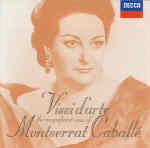This generously filled (157 minutes) two-disc set covers a cross-section of Montserrat Caballé’s recordings made between 1970 and 1984, spanning most of her prime years. And what a prime! A lyric soprano irresistible in some parts of the spinto repertoire (as in her EMI Aida with Muti), she was incomparable among her peers for breath control that enabled sustained arcs of melting legato phrasing, soft trills, and pianissimos the likes of which had not been heard since Milanov’s heyday. She had the vocal range to produce a full low register, a warm middle, and a brilliant top. Her flaws were more sins of omission than commission–a tendency, at least on some of her studio recordings, to slip into blandness, relying on the sheer beauty of her voice to carry the load. While she was high among the top proponents of the Verdi and Puccini roles she sang, her full strengths were revealed in the bel canto operas where her technical virtuosity allowed her to spin ravishing sounds, easily heard throughout this set.
Caballé’s bel canto repertoire is somewhat scanted in Decca’s collection. We get Adalgisa’s duet with Sutherland’s Norma, although Caballé was a stunning Norma herself. But she’s as stunning an Adalgisa, a role usually taken by mezzos. Here Caballé characterizes Norma’s young rival well, warmly shading her lines in “Mira, O Norma” to perfection. She could have given us an unforgettable Lucia too, but the excerpts from her misbegotten Philips recording illustrate conductor Jésus Lopez-Cobos’ quaint notion that performances of Donizetti operas should adhere strictly to the Urtext, despite the expectations of the composer that performers would embellish the bare notes. Despite some beautiful if necessarily austere singing, a more traditional approach is something Caballé could, and should have done wonderfully.
Freed of such artificial straitjackets, the selections from Rossini’s Elisabetta display her feeling for the idiom. Early Verdi was raw meat for her too, and the scenes from Il corsaro, I masnadieri, and Luisa Miller, especially the latter, where she spins delicately ravishing pianissimos, are superb. She’s also good as Amelia in the Un ballo in maschera scenes, dueting fabulously with a golden-voiced José Carreras. But her beautifully sung scene at the graveyard suffers from Colin Davis’ bland conducting and her own failure to fully convey Amelia’s feelings of terror. In other words, great as Caballé was, she was no Callas.
Caballé starred in several other Davis-conducted complete operas on Philips, including the Tosca from which the set’s title aria derives. It suffers slightly from rhythmic slackness, but that incomparable voice pours out such lovely long, effortless lines you just want to keep hitting the repeat button. There’s so much more here that ought to be mentioned–her Fiordiligi from Cosi fan tutte, her stunning Turnadot Liú, La Gioconda’s “Suicidio!”, even her final scene from Strauss’ Salome–but it’s better to just get the set and hear them yourself. If you do, you’ll also get some sterling partners in duets and trios–Bergonzi, Carreras, Pavarotti, and others of that ilk.
The only caveat is to check whether you have most of these 49 tracks, many of them drawn from still-available complete opera sets. If you do, then this set becomes more a convenient way to dip into Caballé’s art than the indispensable purchase it should be for Caballé beginners. That, of course, raises the issue of endlessly deleting, recycling, and repackaging that the industry has discovered as a way to milk more juice from its back catalogue. But let’s leave that one for another day; meanwhile, enjoy a great voice. [5/5/2003]
































